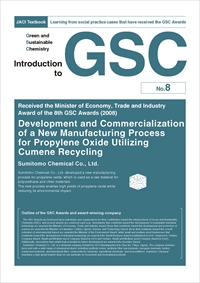Introduction to GSC No.8
Received the Minister of Economy, Trade and Industry Award of the 8th GSC Awards (2008)
Development and Commercialization of a New Manufacturing Process for Propylene Oxide Utilizing Cumene Recycling
Sumitomo Chemical Co., Ltd.
This page contains part of the PDF version.
Please see the PDF version for details.
Please see the PDF version for details.
The Minister of Economy, Trade and Industry Award at the 8th GSC Awards (FY2008) was awarded to Sumitomo Chemical Co., Ltd.’s “Development and Commercialization of a New Manufacturing Process for Propylene Oxide Utilizing Cumene Recycling.” In traditional manufacturing processes for propylene oxide, there are two issues: 1. the production of substantial quantities of chloride compounds as byproducts, which have a significant environmental impact; 2. the production of the co-products affects the market price of propylene oxide, diminishing the competitiveness of the manufacturing process. In contrast, Sumitomo Chemical’s innovative technology enables the production of propylene oxide with high yield and without any by-products, while also demanding less energy.
Outline of award-winning company
Sumitomo Chemical Co., Ltd. is a chemical company founded in 1913 (headquartered in Chuo-ku, Tokyo, Japan). The company manufactures and sells a wide range of chemical products, including synthetic resins, synthetic fiber raw materials, inorganic materials, battery component materials, photofunctional films, semiconductor materials, agricultural chemicals, and feed additives. Sumitomo Chemical maintains a high global market share in raw materials for household and horticultural pesticide.
The Path to Technology Development
What were the intentions that started development toward realizing the sustainable progress of society?
What were the intentions that started development toward realizing the sustainable progress of society?
The chemical products used in everyday life are manufactured from raw materials through various chemical reactions. Propylene oxide (PO) is an important raw material for numerous chemical products such as polyurethane, which is used to make sponges and car seat cushions. Global production of PO exceeds 10 million tons per year, and its demand has been steadily increasing.

The structure of propylene oxide (left) and polyurethane synthesized from PO (right)
Until the 1990s, commercialized PO manufacturing processes included the “chlorine method” and the “organic peroxide method”. Even though the chlorine method affords only PO without co-products, a large volume of wastewater containing calcium chloride is discharged, causing a higher environmental impact. On the other hand, the organic peroxide method generates more than twice the volume of the co-products as the target PO. In this scenario, the market prices of the co-products significantly affect the competitiveness of this manufacturing process.
Prior to the development of this new process, Sumitomo Chemical had manufactured PO using the organic peroxide method through a joint venture. The demand for PO was strong, and transactions were steady. However, when the demand for co-produced styrene and its market price deteriorated, the PO business was also affected. Additionally, the adoption of the Kyoto Protocol in 1997 led to increased societal interest in the environmental impact of manufacturing processes. Hence, in 1998, Sumitomo Chemical started to develop a sustainable, rationally designed PO-only manufacturing process with low environmental impact. Another company was developing a PO manufacturing process based on the same concept, using hydrogen peroxide (H2O2). This hydrogen peroxide method is a clean PO-only manufacturing process, with water as the only by-product.
To respond to the thriving PO market, Sumitomo Chemical launched a project in 2003 to start PO production at a new plant. The development of a new industrial manufacturing process usually requires a long time, but this project was requested in an exceptionally short timeframe.
Toward Resolution of Issues
What types of technological challenges did the developers face and how did they resolve them?
What types of technological challenges did the developers face and how did they resolve them?
Hastening the development of the new process
The development of a new manufacturing process for a chemical product is conducted in phases, from the laboratory level to bench plants, pilot plants, demonstration plants, and actual production plants, while passing along the results obtained in each phase. Even reactions that occur satisfactorily in the laboratory are not guaranteed to perform well in large-scale facilities, such as production plants. Therefore, the scale of production is gradually increased to overcome any issues that occur in each phase and evaluate the process from multiple perspectives.
To develop the new PO manufacturing process in an exceptionally short timeframe, technology development and basic manufacturing facility esign for each step of the process were conducted in parallel from the laboratory level to the completion of the production plant. This approach is known as “concurrent engineering,” and if successful, it can greatly reduce the development timeline. From the beginning of the development process, laboratory researchers worked together with plant engineers, which required a deeper mutual understanding and cooperation than typical development projects. One of the project members stated, “It was the first time for us to attempt concurrent engineering. It was the quite challenging work.” The efforts succeeded. The typical 10-year development period was achieved in just four years.
Using cumene
The Sumitomo Chemical research team used cumene hydroperoxide (CMHP) as a novel approach instead of isobutane and ethylbenzene that are used in the organic peroxide method. Using CMHP, it is possible to produce only PO without generating co-products, such as styrene and tert-butyl alcohol.
The process involves ① oxidation, in which cumene is oxidized with air to produce CMHP; ② epoxidation, in which PO and cumyl alcohol are obtained from CMHP and propylene; and ③ hydrogenation, in which cumyl alcohol is hydrogenated to produce cumene. A notable feature of this method is cumene recycling, where cumene serves as a reaction mediator and an oxygen carrier.

PO manufacturing process utilizing cumene recycling (Cumene method)
The concept of using CMHP to manufacture PO had existed for many years; however, a catalyst that facilitates efficient epoxidation did not exist, and thus, had to be developed.
Development of a highly active catalyst for epoxidation
Titanosilicate (TS-1: a zeolite containing a titanium framework) is a well-known epoxidation catalyst and exhibits high catalytic activity in the presence of hydrogen peroxide as the oxidizing agent. However, TS-1 exhibited almost no activity when using CMHP.
TS-1 has micropores with a regular size of 1 nm that could fit reactants and serve as active sites for the reaction. The larger the surface area inside the pores, the more space available for the reaction to occur. However, the micropores in TS-1 were too small for CMHP.
Therefore, a larger pore size is required to accommodate CMHP in the cumene-based PO manufacturing process. In this context, mesoporous materials such as silicon dioxide (silica) with larger uniform pores than those in TS-1 were explored. Titanium, which is the active site for epoxidation, was introduced into the silica matrix. Moreover, the number of mesopores was increased to improve reaction efficiency. Notably, titanium was introduced in a highly dispersed state to increase the epoxidation activity, and the catalyst affinity for propylene was increased by making its surface hydrophobic. This silicon oxide catalyst containing titanium “Sumitomo Ti catalyst” was developed by various studies. It exhibited high epoxidation activity when CMHP was used .
Even though mesoporous catalysts had been widely reported in the literature, this is the first instance of the industrial application of a mesoporous catalyst. The company also focused on manufacturing the catalyst with high efficiency and low cost.

Mesoporous structure (left) and Sumitomo Ti catalyst with mesoporous structure (right)
A mesoporous structure refers to a configuration featuring uniformly sized pores with diameters ranging from 2 to 50 nm.
The reaction occurs in the pores of the catalyst; therefore, a mesoporous structure is advantageous for reactions involving large molecules.
A mesoporous structure refers to a configuration featuring uniformly sized pores with diameters ranging from 2 to 50 nm.
The reaction occurs in the pores of the catalyst; therefore, a mesoporous structure is advantageous for reactions involving large molecules.
Development of the new process
Increasing production efficiency and reducing environmental impact were the main objectives of the development of this novel PO manufacturing process . As previously stated, the PO manufacturing process involves three steps: oxidation, epoxidation, and hydrogenation. Concurrent engineering was performed, and the reaction conditions were optimized to increase the reaction rate and yield for high-efficiency PO manufacturing. The heat generated during each step is recovered and used effectively in the other steps. In addition, cumene functions as both a solvent and a reaction mediator, eliminating the need for another solvent. This simplifies the process and reduces energy consumption. Furthermore, cumene is recovered in the hydrogenation step for reuse.
Achieving high yield and energy efficiency
This process enables high yields of PO and requires less energy than other processes. Typically, in manufacturing, tradeoffs exist between increasing yield and reducing energy consumption. For example, although lowering the reaction temperature leads to an increased yield, recovering heat becomes difficult, resulting in energy loss. The use of cumene and the development of high-performance catalysts are key factors; however, they alone are not responsible for the high yield and energy savings. Other factors, such as the optimized reaction vessel and reaction conditions, also contributed to the high yield and energy savings.
A member of the development project said, “Each step is intricately interrelated. So, it was difficult to optimize the overall manufacturing process and understand the behavior of the trace compounds formed in each reaction. Even though the process was understood theoretically, that alone did not make it easy to increase the competitive strengths of the process.” Concurrent engineering played a major role in optimizing the manufacturing process in such a short time period.
Contribution to Society
What is the contribution of this novel technology to society?
What is the contribution of this novel technology to society?
This new PO-only manufacturing process “Cumene method” developed by Sumitomo Chemical is characterized by cumene recycling and efficient PO generation. In addition to solving the problems inherent in the existing chlorine and organic peroxide methods, Sumitomo Chemical’s new method reduces energy consumption and environmental impact. For example, the hydrogen peroxide method, developed around the same time, requires a large amount of energy to recover the solvent methanol. In contrast, this Cumene method that uses cumene also as a solvent, requires less energy to recover and recycle the solvent due to cumene's lower latent heat of vaporization. In addition, energy consumption is further reduced through extremely high yields at each step of the process and efforts to recover the heat generated during the reactions. The estimated energy consumption of the cumenebased method is approximately 40% lower than that of the hydrogen peroxide method.

Comparison of the energy consumption
Moreover, efforts for energy saving contribute to reducing the emissions of carbon dioxide, a recognized contributor to global warming. The reuse of resources and reduced energy requirements of this technology make it a practical example of Green and Sustainable Chemistry (GSC).
The production of PO at a new plant in Chiba began in 2003, as originally planned, and the plant has been operating steadily. Since then, the manufacturing department and the research laboratory have continued to work together to improve this process.
This technology has received considerable attention overseas, and three technology license agreements have been made, resulting in the establishment of plants in Saudi Arabia in 2009, South Korea in 2015, and Thailand in 2020. If more license agreements are made, the global market share of the process is expected to exceed 10%. Expanding the use of this technology should contribute to reducing the global environmental impact. Sumitomo Chemical aims to improve continuously the catalyst and processes for PO manufacturing and expand its technology worldwide.
This page contains part of the PDF version.
Please see the PDF version for details.
Please see the PDF version for details.


